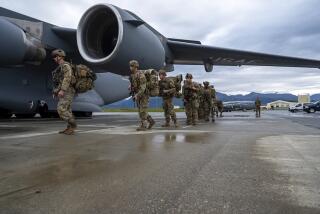U.S. Planes Believed Laser Targets of Soviet Ships : Military: Actions against spotter aircraft apparently took place west of Hawaii. Officials plan to protest the incidents in Moscow next week.
- Share via
WASHINGTON — Soviet ships apparently aimed lasers at U.S. military aircraft in the Central Pacific on four occasions in the last three weeks, at least temporarily impairing the eyesight of an American crewman, the Pentagon said Thursday.
The four incidents, the first on Oct. 17 and the most recent on Nov. 1, occurred west of Hawaii in an area where Soviet intelligence vessels often monitor Soviet missile test splashdowns. U.S. spotter planes were in the area observing the Soviet vessels, Pentagon officials said.
Pentagon officials declined to speculate on the motivation for the incidents. Although shipborne lasers are designed to gauge distances or guide weapons, military experts say, they can be used to blind or disable the pilots of aircraft.
An Air Force pilot was temporarily blinded in a similar incident in October, 1987, and the Pentagon has repeatedly complained to the Soviets about laser “illumination” of American and other Western aircraft.
An Administration source said that U.S. officials will protest the Soviet action privately at a meeting next week in Moscow on preventing dangerous military incidents. But the official said the Administration will not lodge a formal diplomatic protest.
Pentagon officials attempted to minimize the recent incidents, which took place as Soviet and U.S. officials were planning a meeting of President Bush and Soviet President Mikhail S. Gorbachev aboard warships in the Mediterranean on Dec. 2 and 3.
Pentagon spokesman Pete Williams declined to comment on whether Soviet-U.S. relations, which have warmed dramatically in recent months, might be damaged by the apparently hostile acts.
“I will not characterize the incident beyond describing it,” he said.
Directing lasers at ships and aircraft would be barred under a treaty signed last spring that is aimed at preventing dangerous military encounters between the superpowers. The treaty, which is to take effect in January, is designed to improve communications so that minor incidents do not escalate into crises.
“We certainly don’t like it, and the agreement obligates them not to do it after Jan. 1,” an Administration official said. “We’ll raise it in the proper channels.”
In addition to restricting the use of lasers, the agreement deals with the inadvertent straying of troops, planes or ships into hostile territory, the risk of accidental confrontation in tense areas like the Persian Gulf and interference with peacetime communications.
The injured serviceman, who was not identified, suffered headaches, loss of color vision and other eye problems, Air Force officials said. He is undergoing medical tests to determine whether the damage is permanent.
Williams said the man had been wearing special laser eye protection and that use of such gear is now “standard procedure” for U.S. personnel in areas where laser beams might be directed at them, Williams said. It was not clear why the gear did not perform properly.
“The military is also taking further precautions to minimize exposure and injury from laser illuminations,” Williams said, noting that the details are classified.
He provided the following details of the four recent incidents:
On Oct. 17, a crewman aboard an Air Force HC-130 observation plane about 1,200 miles southwest of Hawaii experienced “what may have been possible laser illumination” as the plane was observing a Soviet “research” ship. The crewman who made the report suffered the eye injury.
On Oct. 28, the flight crew of a Navy P-3 observation plane about 1,800 miles southwest of Hawaii reported possible laser illumination from the same Soviet vessel. No injuries were reported.
On Nov. 1, an Air Force HC-130, flying about 1,000 miles west of Hawaii, reported possible laser illumination from a Soviet vessel. A few minutes later, a similar report was received from an Air Force WC-130, a four-engine weather observation plane, located 780 miles south of the first aircraft. Again, no injuries were reported.
Air Force officials identified the Soviet ship involved in three of the four incidents as the missile range vessel Marshal Nedelin, a sophisticated electronic surveillance ship used to monitor missile tests.
More to Read
Sign up for Essential California
The most important California stories and recommendations in your inbox every morning.
You may occasionally receive promotional content from the Los Angeles Times.













